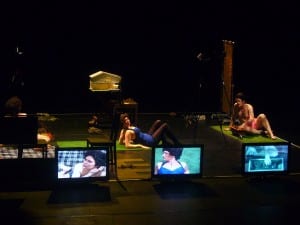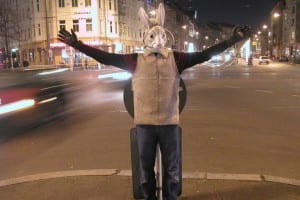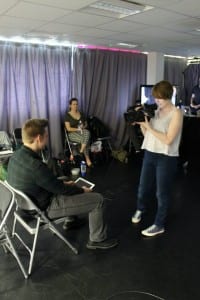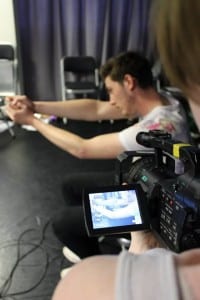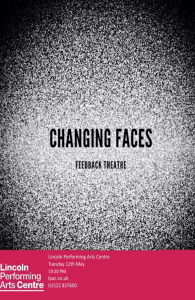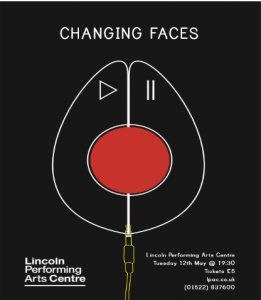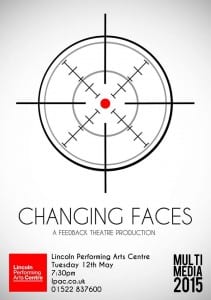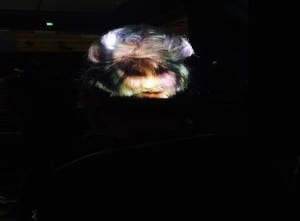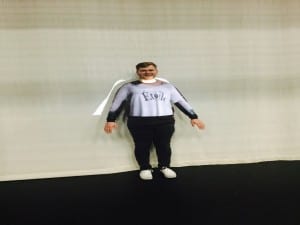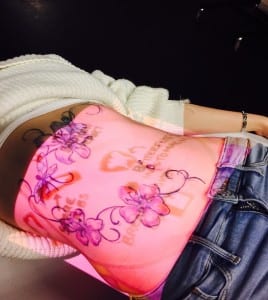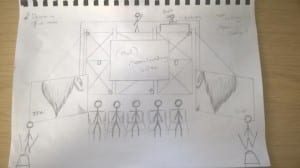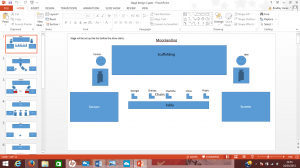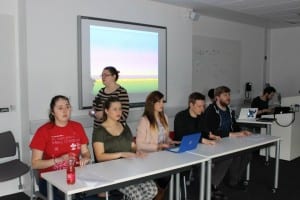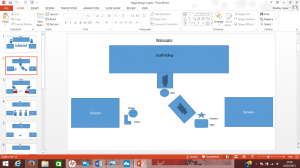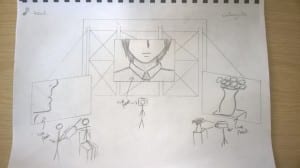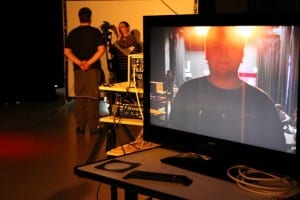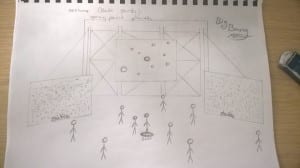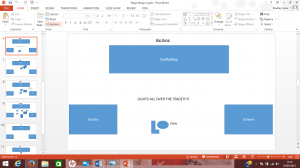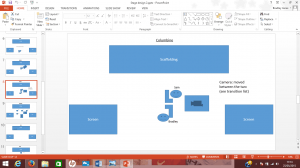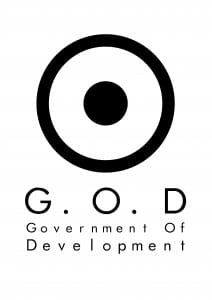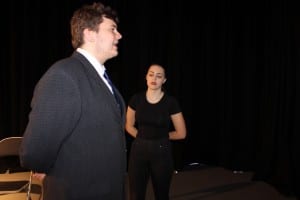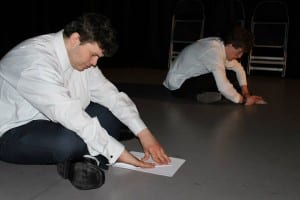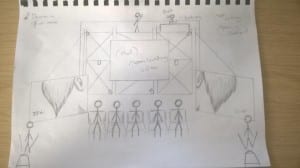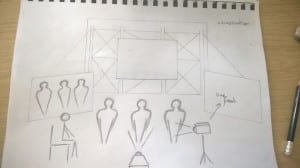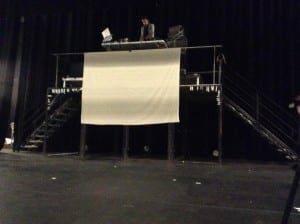I started this module with, for lack of a better term, absolutely no experience or understanding of technology. However, I always had the interest to learn about, not only how to use, but how to execute a well designed piece of theatre with the use of multimedia, this was my influence for taking this module.
We started our multimedia performance workshop with a short demonstration on how to properly use, set up and disassemble the cameras, projectors and projection screens with the guidance from Darren. Once these were all set up, we were split into two groups to experiment with the cameras and projection. The group I was placed in looked at mainly how two projected images can be created from one camera shot We also played around with live bodies being seen on stage, however the image you see being projected is one from a completely different angle, therefore giving the scene two definitions. This began our multimedia journey.
Our following practical session had us working with “makey makeys”. These are devises that allow you to create sounds through electrical currents. If the electrical current can pass through the item, it can be used to make music through the “makey makey”. We used bananas when first being shown the devises. After grasping the use of the makey makeys, we split into two groups to explore what we could come up with when using these devises. We decided to use flowers, and instead of making music, each flower when touched would say one of their own phrases. We recorded and edited these phrases, then set them so each flower had their own phrase to say when they were touched and the circuit was complete.
Our first week of reading showed an introductory of internet mapping. We saw the investigation of multimediality – mediums such as TV, radio and books. Transmediality, a transition from one media to another, for example book to film. Finally intermediality, where one medium is dependant on another. Before trying to look at foundations for a show, it is important to understand all aspects of readings and workshops set for the module to explore what media the LPAC has to offer that can be properly incorporated in our show.
We were shown a series of short documentaries called “Everything is a remix”, a series about how most media such as film and music is not original, but either based or influenced by one or more artist. This was something I found personally helpful when thinking about making a performance. We were all already trying to think of ways we could make a good multimedia performance, however were all worried about being too similar to performances we had previously seen. This series settled our minds a bit, knowing that using influences in a piece is not something that is frowned upon, but can be encouraged.
We were given many pieces to research and watch, as well as weekly readings. I found these set projects very useful in my education for multimedia. I found for myself personally, being a kinetic learner, that watching different multimedia pieces helped my understanding further than the readings, but this is purely based on how I work when it comes to research and understanding. I found Gob Squad’s “Revolution Now!” to be very insightful for me. Their use of live camera feed, projection, viewing screens from outside the theatre onto the streets of London, the use of audience participation and even having their image recorded on camera so they become, to the passers by on the street, performers themselves. I found this useful as a way to think about different uses for media, rather than just thinking about cameras and projection on stage.
To begin the progress of creating a show, we were all asked to write down different themes, company roles and ideas for material for our performance. I was assigned performer and marketing. I chose performer as I feel that performing is my strongest point, whereas roles such as director or stage manager, I feel as I am not a natural leader who is comfortable with directing and guiding people, a role that requires that sort of person would have been wasted on myself, and would have become annoying for the group. I also chose marketing as I was assigned marketing in a previous module and found I not only enjoyed the role, but was something I found great interest in as I have a broad understanding of different ways to advertise a performance or product.
One exercise that really stands out in my mind as a part of our work in progress would be an exercise that Wes set up for us. He had two performers on stage, improvising a scene without the use of music or film for inspiration. The only stimuli the two individuals had to go on was one instruction from the directors. I found this exercise as a performer to be incredibly useful. As a rule, I enjoy improvisation and find I can be quite successful at it, however this was a whole new group to work with. So by being thrown into an exercise where you have to work together so quickly really helped me break the ice with my fellow performers.
With directors, performers, writers, stage management, tech team and other vital roles set amongst the group, we could start to begin the thinking and researching process of our performance. This was a process that began very slowly. Everyone has mass amounts of ideas, none of which actually worked together. Workshops were being made by the directors to help these ideas grow and for more stimuli to come from one idea so some idea and scene linking could begins. Unfortunately, and as to be expected from a work in progress, this was not the case and the group soon found ourselves back to square one, with motivation and enthusiasm beginning to dip.
During one rehearsal, the idea of historical events and conspiracy theories came up. We all paired up and began to think of historical events that stuck out in our minds. After brainstorming these events, we then got into groups for research on each event for more information. One of my ideas that linked with a conspiracy theory was the moon landing in 1969. I began to research my ideas of the moon landing, the Queen’s coronation and the conspiracy theory that Paul McCartney died and the man who is known as Paul is an imposter. During my research, the idea of a faked moon landing was everywhere. There are so many theories on why and how the moon landing was faked, and after consulting with the group and the directors, it was something we were all interested in keeping in the performance. As far as my other research points were concerned, they did not offer much for conspiracy theories. The Queen’s coronation was not something people conspired against, and as for Paul McCartney being dead with someone else pretending to be him, the evidence to back up the theories are not only limited, but very ludicrous. Even researchers who try to defend the theory came out with the answer that he is, in fact, still alive. I also believe that this conspiracy theory is not well known enough for the audience members to understand. After researching, we all came back after Easter with a basis of events we all found interesting. One of our ideas were to link two events together, for example, we demonstrated the Wright Brothers working on the blue prints of the first aeroplane, and then linked that to the 911 terrorist attack where two planes were flown into the world trade centre.
After finally researching and coming up with a structure for our performance, we chose the following for our scene.
1.Moon Landing
2.Watergate
3.The Wright Brothers
4.The journey of Churchill’s life in the war
5. Emily Davidson and her protest for The Suffragettes
6.The Big Bang Theory
7.Queen Elizabeth the second’s coronation
8.Columbine shootings
9.Assassins from their point of view
10. The Diary of Anne Frank
11.AIDS being seen as a “cancer” and finally
12. News room finale.
Each scene was thought out carefully from the directors and writers and after a lot of hard work, we had a structure to work with, rehearse and progress. The directors kept in close contact with Wes, and we had constant feedback from Wes on the progress of our performance. We were told from Wes it was very important that we did not “spoon feed” the audience, so our scenes had to be intelligently displayed, however have the right balance so it wasn’t so vague that no evidence of which event was taking place.
As a performer, I was asked by the directors to be present on stage as much as possible. This meant I was in a number of scenes, starting from Moon Landing, Watergate, Big Bang, Assassins, Freddie Mercury and AIDS, and finally the News Room finale. Although The Big Bang theory was the scene in which only I spoke, I found the most challenging scene for me was Assassins. There is a very large difference between acting and performing. To keep focus on stage for a long period of time, not allowing yourself to move to break concentration. Any small move from myself would have been enough to distract the audience from Adam speaking to myself, for the wrong reasons. Keeping myself focused and still for, as someone who constantly fidgets, was a rather large challenge that I feel I executed well.
After a full run through with Wes present, he gave me the note that I do not seem myself, or anyone on stage. I feel my uncomfortable feeling came from being completely out of my comfort zone. In majority of performances I’ve been a part of, I always get cast as the comedy character, and as much as I wanted to be given the opportunity to show I’m more than just the funny character, I was never aware of how much I relied on that mask for confidence. I was not aware I was being seen as someone with low confidence on stage until Wes had pointed it out, I took this note and (hopefully) changed how I performed on stage to someone with full confidence.
When going through the complete run through, there was a slight element that none of us had thought about. During rehearsal we were without the full use of technology that we were using for the performance. We had all been taught how to use the technology, and knew exactly what was being used for which scene. However, we had not taken into account the transitions between scenes. Taking on and off all the technology, as well as set and props needed for the following scene. Our first attempt of transitions ended up being an empty stage for 5 minutes, with no one knowing who was taking what on or off, or in some cases, everyone rushing on at once to collect the same item. This problem, being so close to opening night, had to be rectified quickly. Once gathering as a group and sorting out who was taking off, moving and bringing on pieces of equipment, the transitions ran smoothly.
I found throughout the process, using technology was far more difficult for not only myself, but for the group as well. The multimedia technology throughout the performance was media that I believe we all underestimated. From angles and projection, to thinking outside the box and trying not to be cliché with what we did with the technology. For example, during the moon landing scene we had two live bodies on stage speaking the Nixon and Kennedy speeches, both looking towards a camera to give the impression of a recorded press conference for the audience. However, when watching the projection screens behind the actors, they were switched. So as one is speaking, the audience found themselves torn from one end of the stage to watch the actor, and the opposite side of the stage to watch the projection.
My experience of multimedia performance has been one I’ve thoroughly enjoyed, the module and the people. Everyone took on their part, and stuck to it wonderfully. I started the module with such limited knowledge of technology, and in complete honesty, I wasn’t even aware of the meaning of multimedia. I have learnt so much in such little time, that I now feel comfortable on stage, without being the clown. I can set up, use and disassemble a camera, whereas before I could barely use my camera phone. I’ve learnt how easy technology can make things, but how effective and fun they are to use, such as the makey makeys. Our show, I feel was the perfect example of multimedia performance. Using technology to it’s full potential (in my personal opinion, technology professionals may disagree) but still keeping the performance entertaining for the audience members. The use of technology however, being extremely important. For example, The Suffragette scene consisted of one live body on stage, throwing herself on the floor to represent Emily Davidson throwing herself under the King’s horse in protest. Behind the body played a video of this incident happening, and was looped throughout the scene. Without the use of technology, this scene would not have worked as the audience would have been left in complete darkness. Scenes like this needed that extra boost from technology.
My final thought; well, I couldn’t have enjoyed a module more than I have this one. Our group dynamic was fantastic and although sometimes stress got the better of us, we came out with an amazing group bond and an amazing performance which showed our hard work. It really has been a pleasure.

